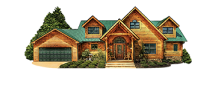Building green goes beyond materials—it focuses on smart design and construction methods that enhance energy efficiency and promote a healthier living environment.
By Jim Kanagy for Hochstetler Log Homes
Building green encompasses an overall lifestyle philosophy which includes building our homes in ways that utilize energy-efficient materials and conserve natural resources today while providing a cleaner environment for our children tomorrow.
Building green is a practical approach to design and construction that balances environmental impact with efficiency. It includes thoughtful design choices, sustainable material selection, and strategic site orientation to maximize energy efficiency.
How Green Building Affects Material Choices
So the question is, how does building green affect the choice of building materials? Log homes utilize a substantial amount of wood in the walls and throughout the entire project. Wood, I might add, is a very sustainable and prolific building material.
Since logs utilize a principle called “thermal mass,” they are an excellent material for conserving energy and saving money. Logs have the ability to absorb and store heat, then release it later, creating a natural thermal break that helps regulate indoor temperatures year-round.
Other Sustainable Building Materials
Non-toxic, sustainable, and natural materials such as stone, glass, and metal are also becoming more popular. Additionally, engineered products like SIP panels, concrete foundations, and energy-efficient windows contribute to a home’s overall sustainability. Sustainable green building practices have our families' interests at heart.
By considering the type of materials we use, we can lower the energy demands of our homes and create a cleaner environment for future generations.









